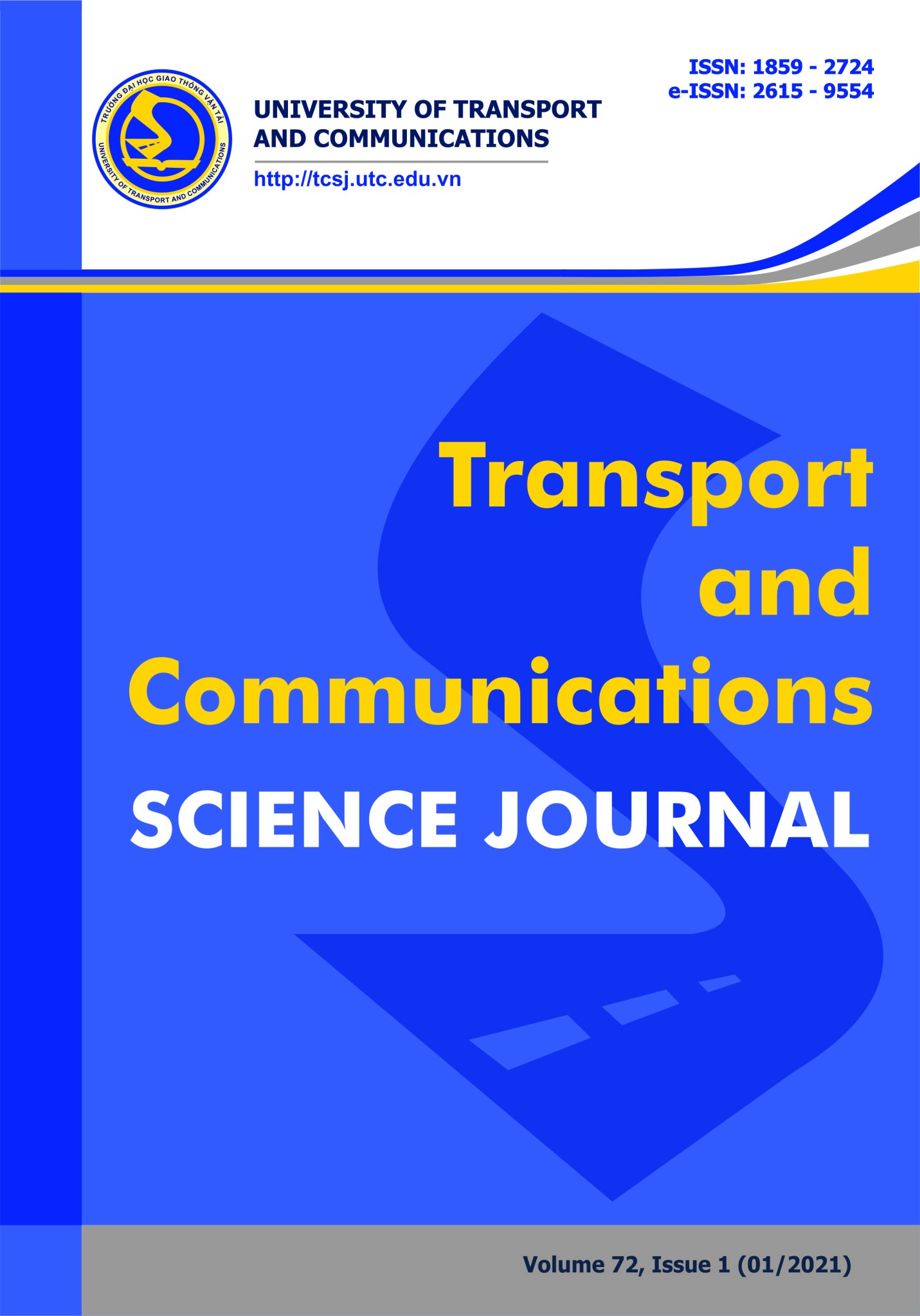Analysis of impacting factors for soil-cement column combined high strength geogrid
Email:
thailinhdkt@utc.edu.vn
Từ khóa:
Soil cement-column, Geogrid-reinforced, efficient of load transmission numerical model.
Tóm tắt
Soil-cement column combined with geogrid on top or Geogrid Reinforced Pile Supported (GRPS), is used to construct structures on soft ground. Because of its high tensile capacity, the geogrid is spread on the top of the soil-cement column to form a soft transmission layer, increasing the capacity transferred to the columns, reducing a part of the load transmitted to the soft soil between the columns. The numerical analysis results of the GRPS with a high strength geogrid showed four major factors affecting transmission the efficacy of the column (Ef) and the tensile force of the geogrid including effective vertical load (v’); the ratio of the distance between the columns and the column’s diameter (s/D); the ratio of the elastic modulus of the soil-cement column to the deformation modulus of soil (Ec/Es); the tensile stiffness of the geogrid (J). The efficacy of the column (Ef) increases rapidly with an increase in effective vertical load (v’) from 0.23 to 0.44. In contrast, the transmission efficiency (Ef) decreases from 0.60 to 0.37 when s/D increased. When the ratio Ec/Es > 150 and J > 8000 kN/m, the tensile force of the geogrid tends not to change much.Tài liệu tham khảo
[1]. J. Han, J. Huang, A. Porbaha, 2D numerical modeling of a constructed geosynthetic-reinforced embankment over deep mixed columns, Contemporary issues in foundation engineering, (2005) 1-11. https://doi.org/10.1061/40777(156)13
[2]. D. T. Bergado, P. V. Long, B.R. S. Murthy, A case study of geotextile-reinforced embankment on soft ground, Geotextiles and Geomembranes, 20 (2002) 343-365. https://doi.org/10.1016/S0266-1144(02)00032-8
[3]. Standard, British, 8006-1 Code of practice for strengthened/reinforced soils and other fills, British Standards Institution, (2010).
[4]. N. Yapage, Numerical modelling of geosynthetic reinforced embankments over soft ground improved with deep cement mixed columns, (2013). http://handle.uws.edu.au:8081/1959.7/uws:31350
[5]. J. Han, M. A. Gabr, Numerical analysis of geosynthetic-reinforced and pile-supported earth platforms over soft soil, Journal of geotechnical and geoenvironmental engineering, 128 (2002) 44-53. https://doi.org/10.1061/(ASCE)1090-0241(2002)128:1(44)
[6]. S.J.M. Van Eekelen, A. Bezuijen, A. F. Van Tol, Analysis and modification of the British Standard BS8006 for the design of piled embankments, Geotextiles and Geomembranes, 29 (2011) 345-359. https://doi.org/10.1016/j.geotexmem.2011.02.001
[7]. R. P. Chen et al., Tensile force of geogrids embedded in pile-supported reinforced embankment: A full-scale experimental study, Geotextiles and Geomembranes, 44 (2016) 157-169. https://doi.org/10.1016/j.geotexmem.2015.08.001
[8]. Yapage, N. N. S., Liyanapathirana, D. S., Poulos, H. G., Kelly, R. B., & Leo, C. J, Numerical modeling of geotextile-reinforced embankments over deep cement mixed columns incorporating strain-softening behavior of columns, International Journal of Geomechanics, 15 (2015) 04014047. https://doi.org/10.1061/(ASCE)GM.1943-5622.0000341
[9]. J. Huang, J. Han, J. G. Collin, Geogrid-reinforced pile-supported railway embankments: A three-dimensional numerical analysis, Transportation research record, 1936 (2005) 221-229. https://doi.org/10.1177/0361198105193600125
[10]. M. Bouassida, A. Porbaha, Ultimate bearing capacity of soft clays reinforced by a group of columns - Application to a deep mixing technique, Soils and foundations, 44 (2004) 91-101. https://doi.org/10.3208/sandf.44.3_91
[11]. T. Himeno et al., Study on effects of specimen size of unconfined compressive strength of improved soil, Lowland Technology International, 20 (2019) 448-454. http://cot.unhas.ac.id/journals/index.php/ialt_lti/article/view/604
[2]. D. T. Bergado, P. V. Long, B.R. S. Murthy, A case study of geotextile-reinforced embankment on soft ground, Geotextiles and Geomembranes, 20 (2002) 343-365. https://doi.org/10.1016/S0266-1144(02)00032-8
[3]. Standard, British, 8006-1 Code of practice for strengthened/reinforced soils and other fills, British Standards Institution, (2010).
[4]. N. Yapage, Numerical modelling of geosynthetic reinforced embankments over soft ground improved with deep cement mixed columns, (2013). http://handle.uws.edu.au:8081/1959.7/uws:31350
[5]. J. Han, M. A. Gabr, Numerical analysis of geosynthetic-reinforced and pile-supported earth platforms over soft soil, Journal of geotechnical and geoenvironmental engineering, 128 (2002) 44-53. https://doi.org/10.1061/(ASCE)1090-0241(2002)128:1(44)
[6]. S.J.M. Van Eekelen, A. Bezuijen, A. F. Van Tol, Analysis and modification of the British Standard BS8006 for the design of piled embankments, Geotextiles and Geomembranes, 29 (2011) 345-359. https://doi.org/10.1016/j.geotexmem.2011.02.001
[7]. R. P. Chen et al., Tensile force of geogrids embedded in pile-supported reinforced embankment: A full-scale experimental study, Geotextiles and Geomembranes, 44 (2016) 157-169. https://doi.org/10.1016/j.geotexmem.2015.08.001
[8]. Yapage, N. N. S., Liyanapathirana, D. S., Poulos, H. G., Kelly, R. B., & Leo, C. J, Numerical modeling of geotextile-reinforced embankments over deep cement mixed columns incorporating strain-softening behavior of columns, International Journal of Geomechanics, 15 (2015) 04014047. https://doi.org/10.1061/(ASCE)GM.1943-5622.0000341
[9]. J. Huang, J. Han, J. G. Collin, Geogrid-reinforced pile-supported railway embankments: A three-dimensional numerical analysis, Transportation research record, 1936 (2005) 221-229. https://doi.org/10.1177/0361198105193600125
[10]. M. Bouassida, A. Porbaha, Ultimate bearing capacity of soft clays reinforced by a group of columns - Application to a deep mixing technique, Soils and foundations, 44 (2004) 91-101. https://doi.org/10.3208/sandf.44.3_91
[11]. T. Himeno et al., Study on effects of specimen size of unconfined compressive strength of improved soil, Lowland Technology International, 20 (2019) 448-454. http://cot.unhas.ac.id/journals/index.php/ialt_lti/article/view/604
Tải xuống
Chưa có dữ liệu thống kê

Nhận bài
05/10/2020
Nhận bài sửa
30/10/2020
Chấp nhận đăng
06/11/2020
Xuất bản
25/01/2021
Chuyên mục
Công trình khoa học
Kiểu trích dẫn
Nguyen Thai, L., Nguyen Duc, M., & Nguyen Hai, H. (7600). Analysis of impacting factors for soil-cement column combined high strength geogrid. Tạp Chí Khoa Học Giao Thông Vận Tải, 72(1), 9-15. https://doi.org/10.47869/tcsj.72.1.2
Số lần xem tóm tắt
257
Số lần xem bài báo
297









